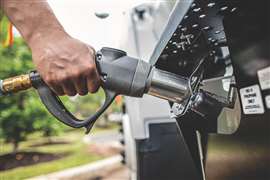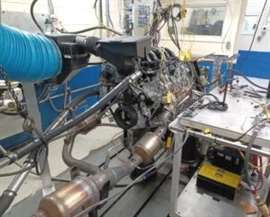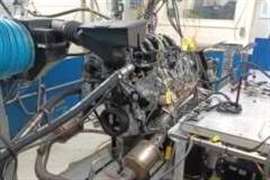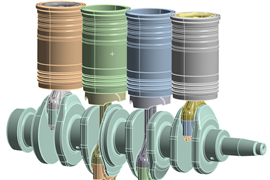Read this article in 中文 Français Deutsch Italiano Português Español
Industry experts discuss propane’s future in IC engines
02 June 2024
Last month, the Engine Technology Forum explored the viability of propane as an alternative fuel in internal combustion (IC) engines in its webinar, “How Propane is Evolving for the Future.”
“Propane as a fuel offers several benefits, including a high octane rating and widespread fueling and availability by over 3,500 distributors,” the Engine Technology Forum said in a press release following the event. “It generally has lower emissions compared to gasoline or diesel, and those emissions can be cost-effectively controlled by utilizing a three-way emissions catalyst similar to gasoline.”
Aftertreatment Differences
Gavin Hale, director of product development and power generation for the Propane Education & Research Council (PERC), addressed the differences between diesel and propane aftertreatment systems during the webinar, saying the biggest opportunity for engine makers and vehicle OEMs vis-à-vis propane is regarding simplified exhaust aftertreatment.
 Fueling a propane delivery truck. (Photo: Propane Education & Research Council)
Fueling a propane delivery truck. (Photo: Propane Education & Research Council)
“They get to reduce emissions with a fuel that’s available and retain most of the design content of the truck,” he said, “which is key, because a lot of other alternative energy sources mean a big tear-up for the OEMs.”
Describing the current diesel engine aftertreatment technology, Hale cited a Bosch SCR system for low-nitrogen oxide (NOx) heavy-duty diesel engines published as part of a June 2020 report by the California Air Resources Board (CARB). He noted that the components of that aftertreatment system include primary and secondary diesel oxidation catalysts (DOC), selective catalytic reduction (SCR), ammonia slip catalysts (ASC), fuel burners, NOx sensors and a diesel particulate filter (DPF).
“Your aftertreatment is way more complicated than your engine, really,” he said. “It becomes the dominant factor.”
By contrast, Hale said aftertreatment for a propane-powered IC engine is considerably simpler.
“With propane today, all you need is a three-way catalytic converter, similar to the ones that you have on your car today. For the 2027 regulations, probably two catalytic converters.”
He added that Phase 3 GHG limits might require slight modifications.
“This really stays the key recipe, with the addition of SCR potentially in the exhaust aftertreatment,” Hale said. “But that depends on the balance of technology that we’re able to deploy in-cylinder to drive the best efficiency in the engine rather than relying on the aftertreatment to catch everything.”
Examining Direct Injection
According to Allen Schaeffer, executive director of the Engine Technology Forum, innovation is also key to making propane viable as an alternative fuel in on- and off-highway applications. One such innovation is direct injection (DI) of propane. In the press release, he said DI technology has “the potential to be a game-changer for expanding the use of propane technology to more applications.”
Manufacturing, engineering and testing company Katech Engineering and fuel systems specialist Stanadyne partnered to explore propane DI in IC engines. They presented their findings during the webinar.
Eric Suits, lead engineer for Katech, said it was worth exploring direct injection of propane for several reasons. He noted that with regard to gasoline engines, direct injection makes up a large part of the light-duty vehicle market, with 73 percent of model-year 2023 vehicles using the technology, according to a February 24 report from the U.S. Dept. of Energy.
“It’s already highly accepted and has its natural benefits and efficiency and improved emissions, which is why the percentages continue to go up of the OEMs currently using it,” Suits said, adding that when coupled with propane’s high octane rating (105) and low emissions, “bringing those two technologies together was an obvious area.”
There were, however, obstacles to overcome. One of these is vapor lock, as propane can exist in either gaseous or liquid form depending upon temperature and pressure, Suits said. If en route to the fuel pump the propane is heated to a certain point and there isn’t a corresponding increase in pressure, it will vaporize and cause a vapor lock situation.
Additionally, Suits said propane direct injection had not been especially well researched. “There have been a few articles written here and there, but from a feasibility standpoint, no one had really looked at tackling it.”
DI Testing
Katech began the DI project with non-firing tests to benchmark current gasoline direct injection (GDI) components on the market, such as injectors and pumps, Suits said, to determine what shortcomings those components had when using them with propane. This led to firing tests intended to benchmark gasoline against propane, with the results given to Stanadyne so the company could determine the specific characteristics required for use with propane.
 The General Motors L8T 6.6L GDI test engine was updated with the Stanadyne components and operated on LPG direct injection. (Photo: Stanadyne)
The General Motors L8T 6.6L GDI test engine was updated with the Stanadyne components and operated on LPG direct injection. (Photo: Stanadyne)
Once it developed the necessary fuel system components, Stanadyne proved out the concept using a General Motors 6.6L L8T V-8 spark-ignited engine as its base engine platform, according to Srinu Gunturu, chief engineer for Stanadyne. He said Stanadyne only changed a few of the hardware components for use with propane fuel.
“On the engine, it’s only the fuel pump and injector,” he said, “and the engine was used as-is.”
Gunturu said Stanadyne had to improve the volumetric efficiency of the pump and make changes to the injector for a higher fuel flow to deliver the right amount of fuel to the engine.
“We added a secondary inlet to be able to make sure that we don’t have that vapor lock inside the pump, especially in the plunger and the sleeve area,” he said.
Suits said engine tests were run at a lambda of 1.0, adding it was important from an emissions standpoint.
“Come 2027 regulations, enrichment during wide-open testing won’t be allowed,” he said. “And with propane, we’re able to easily do that without EGT (exhaust gas temperature) limits or concerns, and it lets the catalyst work as it should.”
DI Test Results
The tests run by Stanadyne and Katech went beyond simply examining engine and component performance.
“We ran some durability up to 250 hours on the engine to prove out that this DI engine is promising for the propane systems,” Gunturu said.
Suits added that the durability testing included on- and off-highway test cycles as well as U.S. Environmental Protection Agency (EPA) and CARB test cycles.
Following the durability testing, Stanadyne examined its fuel system components.
“On the pumps, we haven’t seen any change in the pump performance after running for the 250 hours on the propane” Gunturu said. There was, however, some change in performance in the fuel injector, he said.
“We saw some wear due to lift change in our injectors,” he said. “And we were able to identify what has changed on those — what caused the lift change. We were able to put some fixes.”
Gunturu said close examination revealed wear between the armature and retainer, which Stanadyne attributed to the decrease in lift.
“We did have a design fix already implemented to address this change in the lift and wear of the armature and the retainer,” he said. “Also, we are already planning to do further testing.” Stanadyne is working with OEMs to prove out these corrective actions, Gunturu said.
Suits said that in terms of the engine, the durability testing revealed no significant mechanical wear.
“Often early on, maybe the wording — 10, 20, 30 years on propane — was you need to upgrade the valve seats, you need to upgrade this because it’s propane and there’s no liquid going over the valves,” Suits said. “But modern direct-injected engines account for that. The materials and technologies with that have advanced. So, there was no valve recession, nowhere on the engine side while running on propane, even in a quite stringent test profile.”
Regarding vapor lock, Suits said that Katech successfully addressed that as part of the project.
“One of the big areas Katech focused on, with Stanadyne supplying the hardware, was building a hardware and software system that delivered the propane correctly to the pump and never allowed for a vapor lock condition,” he said.
Via some valves and control systems, Suits said Katech was “able to deliver liquid propane to the pump at all test conditions.”
POWER SOURCING GUIDE
The trusted reference and buyer’s guide for 83 years
The original “desktop search engine,” guiding nearly 10,000 users in more than 90 countries it is the primary reference for specifications and details on all the components that go into engine systems.
Visit Now
STAY CONNECTED




Receive the information you need when you need it through our world-leading magazines, newsletters and daily briefings.
CONNECT WITH THE TEAM














